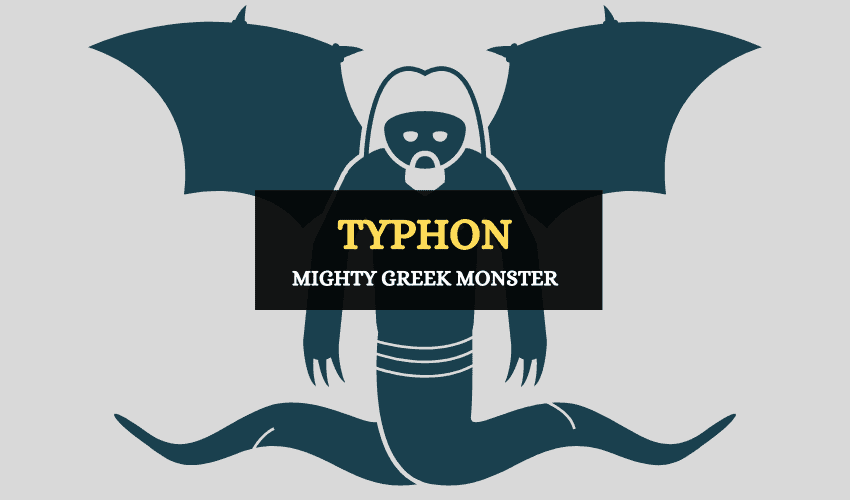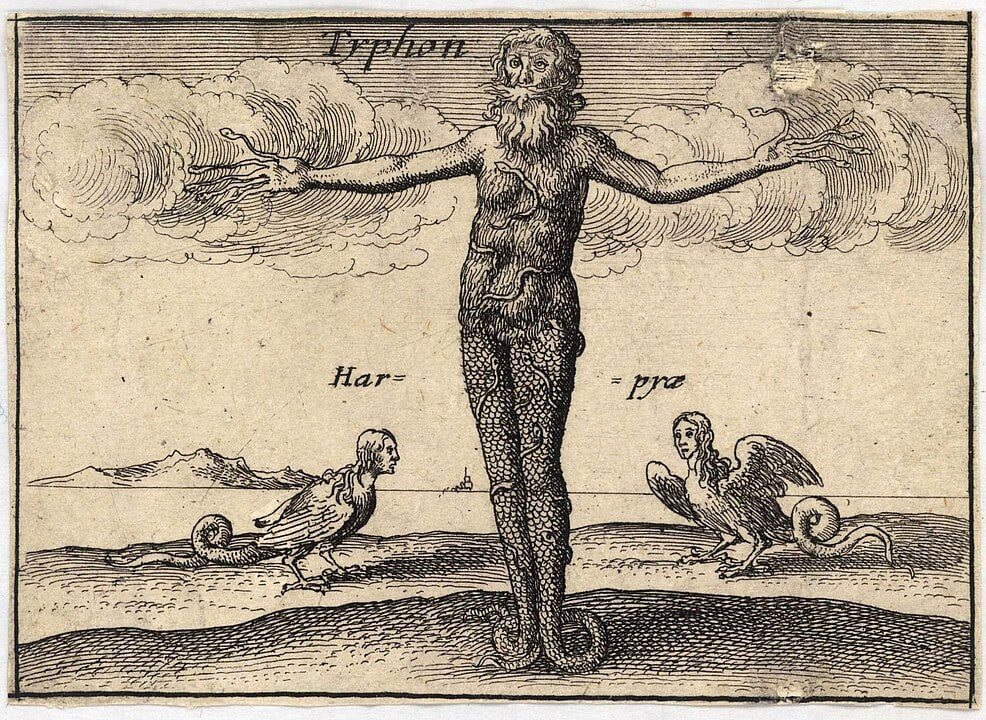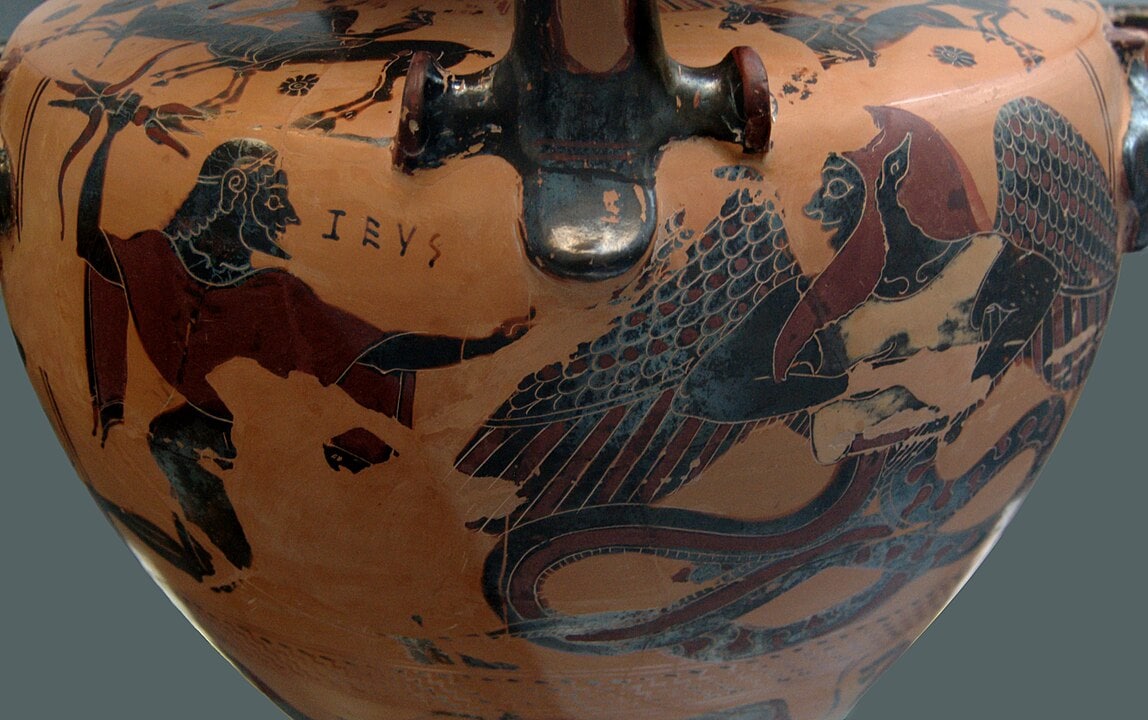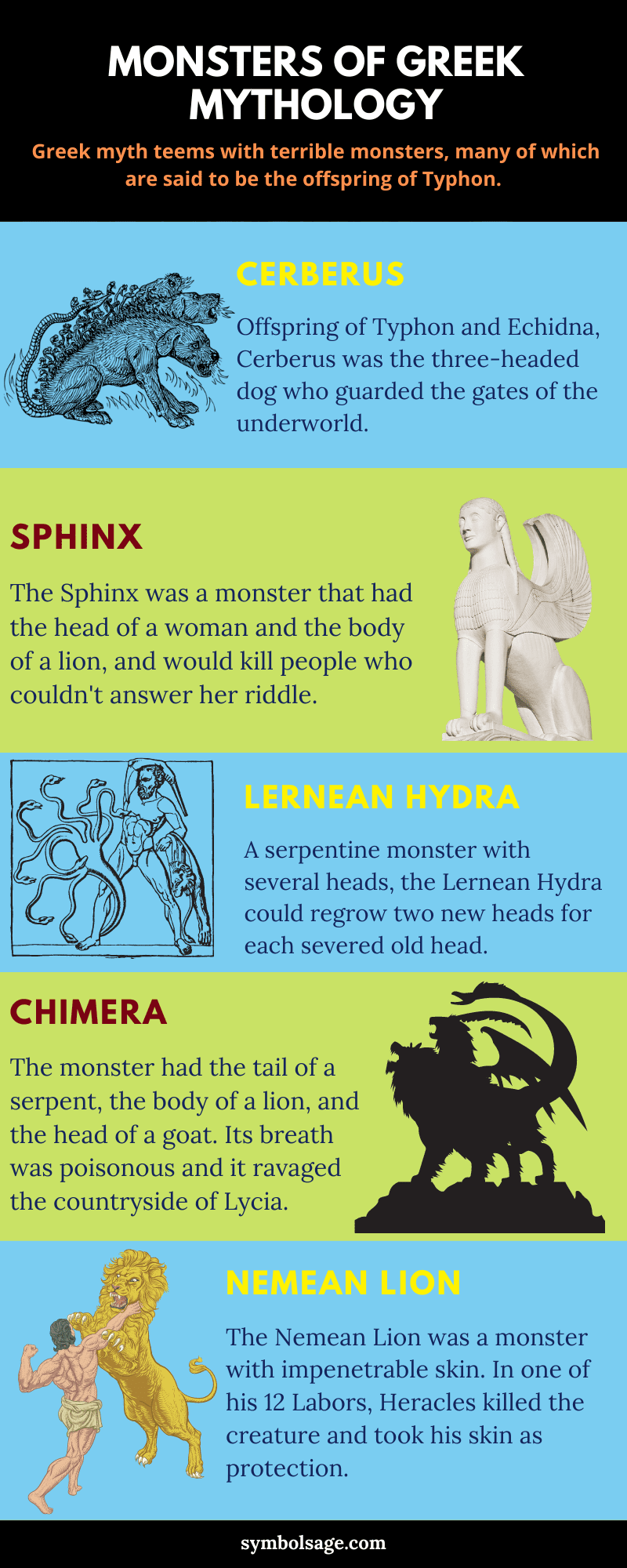
Table of Contents
Besides facing the Giants and the Titans, the Olympians also had to fight Typhon – the mightiest monster in Greek mythology. Typhon was the most terrible creature that existed in the world, and he had a strong influence on the myths. Here’s a closer look.
Who Was Typhon?

Typhon, also known as Typhoeus, was the son of Gaia, the primordial deity of the earth, and Tartarus, the god of the abyss of the universe. Gaia was the mother of a myriad of beings at the beginning of the cosmos, and Typhon was her younger son. Some myths refer to Typhon as a deity of the storms and winds; some others associate him with the volcanos. Typhon became the force from which all the storms and hurricanes of the world originated.
Typhon’s Description
Typhon was a winged fire-breathing giant who had a human body from the waist up. In some accounts, he had a 100 dragon heads. From the waist down, Typhon had two serpents for legs. He had serpent heads for fingers, pointy ears, and burning eyes. Other sources propose that from the waist down, he had several legs from different animals.
Typhon and the Olympians
After the Olympians won the war against the Titans and gained control of the universe, they imprisoned the Titans in Tartarus.
Gaia bears Typhon
Since the Titans were the offspring of Gaia, she wasn’t happy at how they were being treated and decided to act against Zeus and the Olympians. Gaia sent the Gigantes to wage war on the Olympians, but Zeus and the other gods defeated them. After that, Gaia bore the monster Typhon from Tartarus and sent him to attack Mount Olympus.
Typhon attacks the Olympians
The monster Typhon laid siege to Mount Olympus and attacked it with all his strength. According to some myths, his first attack was so strong that he caused injuries to most gods, Zeus included. Typhon was able to capture Zeus after firing blasts of molten rock and fire towards the Olympians. The monster took Zeus to a cave and managed to break his tendons, leaving him defenseless and without escape. The thunderbolts of Zeus were not a match for the power of Typhon.
Zeus defeats Typhon
Hermes was able to help Zeus and heal his tendons so that the god of thunder could go back to the fight. The conflict would last many years, and Typhon would almost defeat the gods. When Zeus regained his full strength, he threw his thunderbolts and attacked Typhon ferociously. This finally took Typhon down.

Getting rid of Typhon
After defeating the monster, some sources say that the Olympians imprisoned him in Tartarus with the Titans and other dreadful creatures. Other sources say that the gods sent him to the underworld. Lastly, some myths say that the Olympians could only defeat the monster by throwing Mount Etna, a volcano, on top of Typhon. There, under Mount Etna, Typhon remained trapped and gave the volcano its fiery characteristics.
Typhon’s Offspring

Besides being the most powerful monster in Greek mythology and waging war on the Olympians, Typhon was famous for his offspring. Typhon is known to be the father of all monsters. In some accounts, Typhon and Echidna were married. Echidna was also a terrible monster, and she had the fame of being the mother of all monsters. Together they had a variety of creatures who would strongly influence Greek mythology.
- Cerberus: They bore Cerberus, the three-headed dog who guarded the gates of the underworld. Cerberus was a central figure in several myths for his role in the domain of Hades.
- Sphinx: One of their offspring was the Sphinx, a monster that Oedipus had to defeat to free Thebes. The Sphinx was a monster that had the head of a woman and the body of a lion. After answering the riddle of the Sphinx, Oedipus defeated the creature.
- Nemean Lion: Typhon and Echidna gave birth to the Nemean Lion, the monster with impenetrable skin. In one of his 12 Labors, Heracles killed the creature and took his skin as protection.
- Lernaean Hydra: Also connected to Heracles, the two monsters bore the Lernaean Hydra, a creature whose heads regrew from a severed neck every time one was cut. Heracles slew the Hydra as one of his 12 Labors.
- Chimera: One of the feats of the great Greek hero Bellerophon was to kill the Chimera, an offspring of Typhon and Echidna. The monster had the tail of a serpent, the body of a lion, and the head of a goat. With its fiery breath, the Chimera ravaged the countryside of Lycia.
Some other offspring associated with Typhon are:
- The Crommyonian Sow – killed by Theseus
- Ladon – dragon that guarded the golden apples in the Hesperides
- Orthrus – two-headed dog that guarded the Cattle of Geryon
- Caucasian Eagle – that ate out Prometheus’ liver each day
- Colchian Dragon – creature that guarded the Golden Fleece
- Scylla – who, together with Charybdis, terrorized vessels near a narrow channel
Typhon Facts
Typhon was the offspring of Gaia and Tartarus.
Typhon’s consort was Echidna, also a fearsome monster.
Typhon had several children, all of whom were monsters. It’s said that all monsters were born from Typhon.
Typhon was borne by Gaia to avenge the Titans.
In Brief
Typhon was a monster so mighty and powerful that he could hurt Zeus and threaten the reign of the Olympians over the universe. As the father of these monsters and many more, Typhon had to do with several other myths in Greek mythology. Typhon is responsible for natural catastrophes as we know them nowadays.








